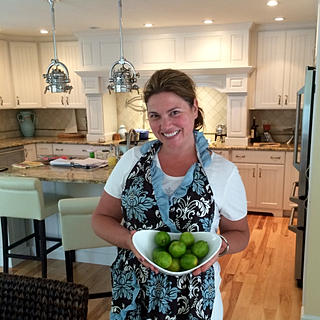Beef and Lamb Meatballs with a Mint and Parsley Glaze.
- Tricia Cohen
- Aug 28, 2017
- 2 min read
Updated: Dec 18, 2022

Medieval food was not disgusting and barbaric, and sorry folks... turkey legs were not gnawed on like you find at a RenFaire. Medieval food, especially for the Royals, had sophistication and flair. The spice trade had opened throughout Europe, introducing flavors like cinnamon, ginger, cardamom, nutmeg, pepper, salt, saffron, and cumin. The chefs were using these interesting spices to create spice combinations that elevated the flavor of dishes, not to mask the flavor as some believe. The chefs used these spice combinations with fresh herbs lement (vinegar, wine, and verjuice) to balance the taste, a technique currently used today.
In addition to the new flavor combinations, the Royals demanded to be entertained by the chefs. This pushed the kitchen staff to find their inner artist and illusionist to make these great presentations. Bowls were made out of beautifully molded, inedible pastry, enormous gilded peacocks served as a centerpiece, and playful trickery took place, making food look unrecognizable to the diners.
King Richard II was quite the lover of these grand events and feasts. His team of 300-plus chefs fed thousands of people daily, and the kitchen staff always looked for ways to wow the guests and King. Many recipes are documented in the 1395 cooking manuscript, A Forme of Cury. Though the manuscript lacks standard measurements, you understand the technique and desired flavors. My recipe is based on one of those "wow" recipes. The original name of the dish was Pomme Dorryse, which translates into "golden apples." The spice-flavored meatballs were covered with a golden sauce, and a twig or herb was added to the top to make it resemble small apples. Imagine being delighted at one of these events and being served what you think is an apple, only to find it a delicious meatball.
I hope you enjoy my interpretation. All of the ingredients used would have been available at that time (okay, okay... creme fraiche is a stretch, but you get the point). You can find more recipes like this in my cookbook A Thyme and Place; Medieval Feasts and Recipes for the Modern Table.

Meatball Ingredients
1-pound ground beef
1-pound ground lamb
2 eggs, slightly beaten
1 ½ tsp. Salt
½ tsp. Ginger
½ tsp. Allspice
¼ tsp. Cardamom
¼ tsp. cinnamon
½ cup zante currants
Mix all the above ingredients in a bowl. Place the combined mixture in the refrigerator to chill; 20-30 minutes is fine. Remove the mixture from the fridge and create 14-16 uniform-sized meatballs.

Par-boil the meatballs for 5-7 minutes in salted, boiling water. Remove the meatballs from the water, and allow them to cool.

While the meatballs cool, make the mint and parsley glaze
2 tbsp. of fresh mint leaves
1 cup of fresh parsley leaves
1 1/2 tbsp. red wine vinegar
1/2 tsp. salt
1/4 tsp. black pepper
1/2 cup olive oil
Place all the ingredients, except olive oil, into a food processor. Pulse until finely chopped. Slowly drizzle the olive oil into the processor. Transfer to a bowl.

With a pastry brush, brush olive oil onto the cooled meatballs.

Grill (or bake) the meatballs on medium heat. Turn the meatballs once they have warmed and have lovely char marks.

Brush the meatballs with the mint and parsley glaze. Leave on the grill until the glaze warms and the meatballs are cooked inside.

Serve with a side of greek yogurt sprinkled with mint.






